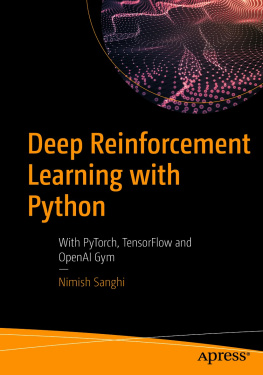Mohit Sewak
Deep Reinforcement Learning
Frontiers of Artificial Intelligence
Mohit Sewak
Pune, Maharashtra, India
ISBN 978-981-13-8284-0 e-ISBN 978-981-13-8285-7
https://doi.org/10.1007/978-981-13-8285-7
Springer Nature Singapore Pte Ltd. 2019
This work is subject to copyright. All rights are reserved by the Publisher, whether the whole or part of the material is concerned, specifically the rights of translation, reprinting, reuse of illustrations, recitation, broadcasting, reproduction on microfilms or in any other physical way, and transmission or information storage and retrieval, electronic adaptation, computer software, or by similar or dissimilar methodology now known or hereafter developed.
The use of general descriptive names, registered names, trademarks, service marks, etc. in this publication does not imply, even in the absence of a specific statement, that such names are exempt from the relevant protective laws and regulations and therefore free for general use.
The publisher, the authors and the editors are safe to assume that the advice and information in this book are believed to be true and accurate at the date of publication. Neither the publisher nor the authors or the editors give a warranty, expressed or implied, with respect to the material contained herein or for any errors or omissions that may have been made. The publisher remains neutral with regard to jurisdictional claims in published maps and institutional affiliations.
This Springer imprint is published by the registered company Springer Nature Singapore Pte Ltd.
The registered company address is: 152 Beach Road, #21-01/04 Gateway East, Singapore 189721, Singapore
Preface
Reinforcement Learning has evolved a long way with the enhancements from deep learning. Recent research efforts into combining deep learning with Reinforcement Learning have led to the development of some very powerfuldeep Reinforcement Learningsystems, algorithms, and agents which have already achieved some extraordinary accomplishment. Not only have such systems surpassed the capabilities of most of the classical and non-deep-learning-based Reinforcement Learning agents, but have also started outperforming the best of human intelligence at tasks which were believed to require extreme human intelligence, creativity, and planning skills. Some of the DQN-based agents consistently beating the best of human players at the complex game of AlphaGo are very good examples of this.
This book starts with the basics of Reinforcement Learning and explains each concept using very intuitive and easy to understand examples and applications. Continuing with similar examples, this book then builds upon to introduce some cutting-edge researches and advancements that make Reinforcement Learning outperform many of the other (artificial) intelligent systems. This book aims to not only equip the readers with just the mathematical understanding of multiple cutting-edge Reinforcement Learning algorithms, but also prepares them to implement these and similar advancedDeep Reinforcement Learningagents and system hands-on in their own domain and application area.
This book starts from the basic building blocks of Reinforcement Learning, then covers the popular classical DP and classical RL approaches like value and policy iteration, and then covers some popular traditional Reinforcement Learning algorithms like the TD learning, SARSA, and the Q-Learning. After building this foundation, this book introduces deep learning and implementation aids for modern Reinforcement Learning environments and agents. After this, the book starts diving deeper into the concepts ofDeep Reinforcement Learningand covers algorithms like the deep Q networks, double DQN, dueling DQN, (deep) synchronous actor-critic, (deep) asynchronous advantage actor-critic, and the deep deterministic policy gradient. Each of the theoretical/mathematical chapters on these concepts is followed by a chapter on practical coding and implementation of these agents grounds-up connecting the concepts to the code.
Mohit Sewak
Pune, India
Who This Book Is For?
This book will equally appeal to readers with prior experience in deep learning, who want to learn new skills in Reinforcement Learning, and to readers who have been the practitioner of Reinforcement Learning or other automation systems and who want to scale their knowledge and skills toDeep Reinforcement Learning. By combining the concepts from deep learning and Reinforcement Learning, we could come closer to realizing the true potential of general artificial intelligence.
Besides presenting the mathematical concepts and contemporary research in the field ofDeep Reinforcement Learning, this book also covers algorithms, codes, and practical implementation aids for both Reinforcement Learning environments and agents. This book is intended to be a guide and an aid for both the types of readers, for the ones who are interested in the academic understanding and being abreast with some of the latest advancements inDeep Reinforcement Learningand also for the ones who want to implement these advanced agents and systems into their own fields.
Ranging from application in autonomous vehicles to dynamic scheduling and management of production process, to intelligent maintenance of critical machineries, to driving efficiency in utility management, to making automated systems for health care, to intelligent financial trading and transaction monitoring, to aiding intelligent customer engagement, and to mitigating high-throughput cyber threats, the concepts learnt in this book could be applied to multiple fields of interest.
The code in the book is in Python 3x. The deep learning part of the code uses the TensorFlow library. Some code also uses the Keras wrapper to TensorFlow.Deep Reinforcement Learningwrappers like Keras-RL are also demonstrated. This book expects basic familiarization in Python with object-oriented programming concepts to enable implementation of distributed and scalable systems.
What This Book Covers?
ChapterIntroduction to Reinforcement Learningcovers the basic design of Reinforcement Learning and explains in detail the concepts like the environment, actor, state, and rewards, and the challenges in each.
ChapterMathematical and Algorithmic Understanding of Reinforcement Learningbuilds upon a strong mathematical and algorithmic foundation to understand the internal functioning in different types of agents.
ChapterCoding the Environment and MDP Solutionillustrates how to build a custom Reinforcement Learning environment in code over which different reinforcement agents can train and also implements the value iteration and policy iteration algorithms over a custom environment.
ChapterTemporal Difference Learning, SARSA, and Q-Learningcovers the TD learning estimation process and the on-policy SARSA and off-policy Q-Learning algorithms along with different types of exploration mechanism.
ChapterQ-Learning in Codeimplements the Q-Learning algorithm in Python via the tabular approach using the epsilon-greedy algorithm for behavior policy.













